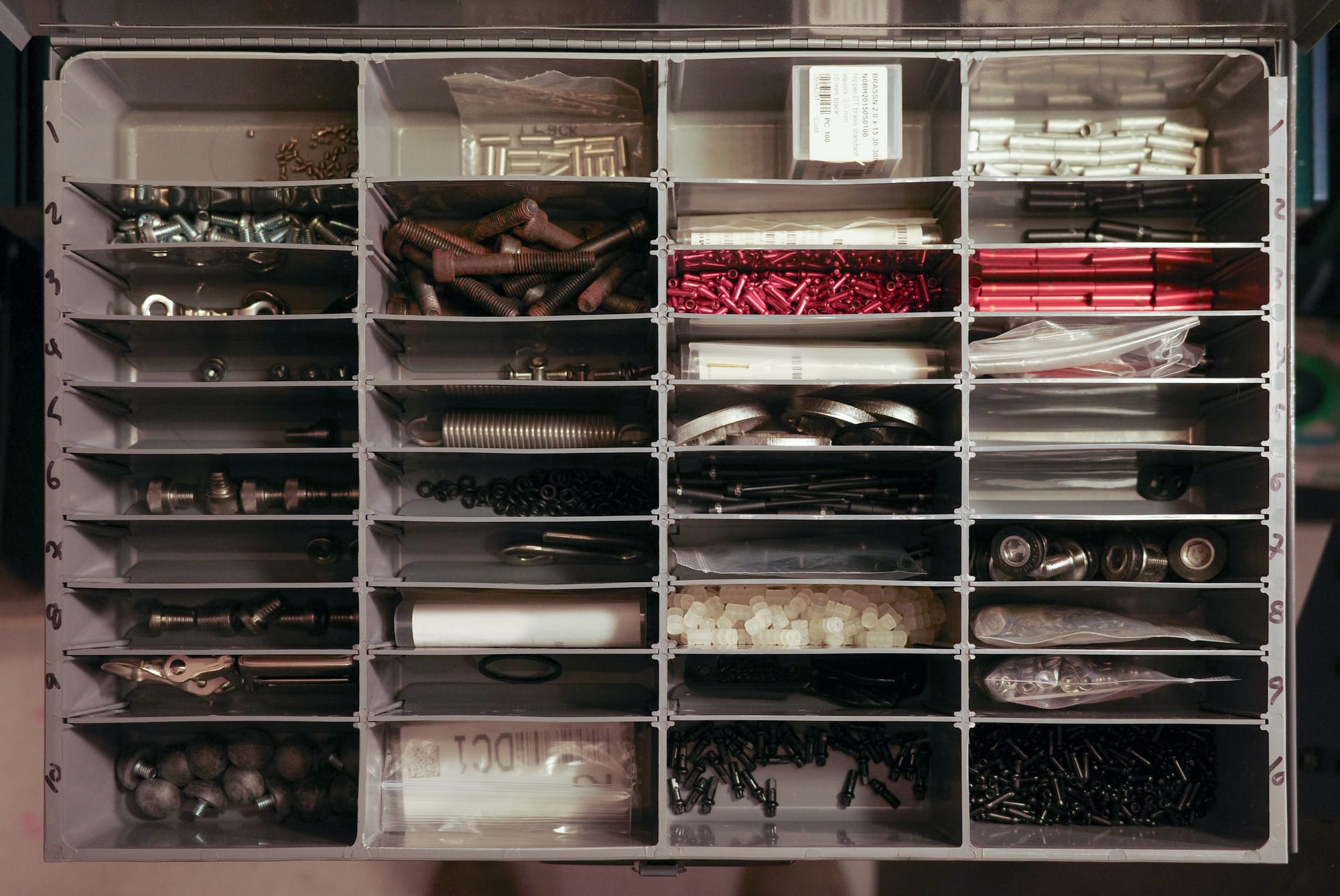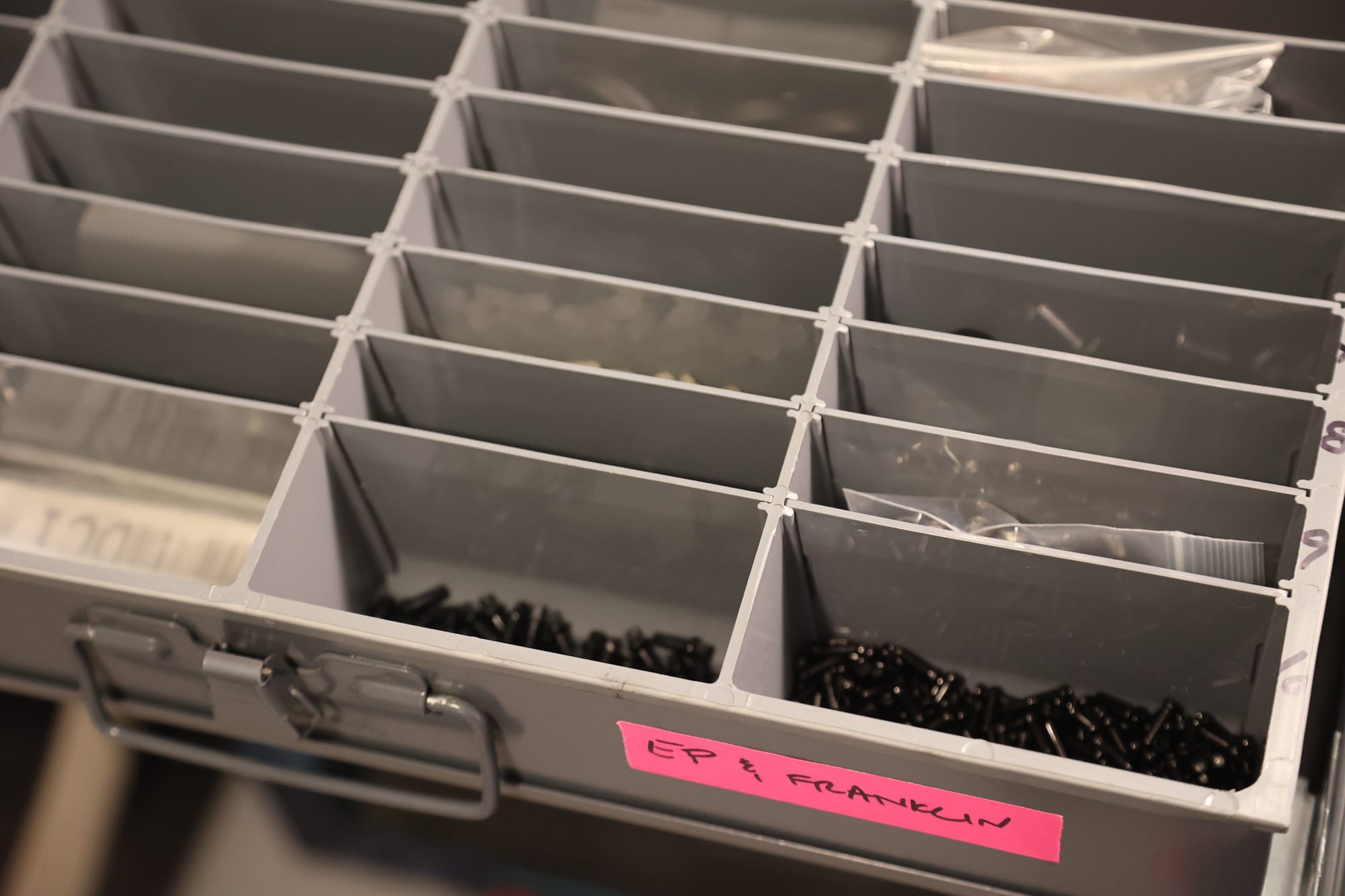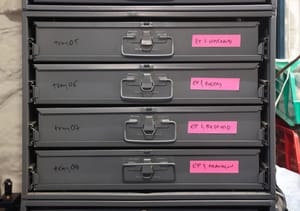A few weeks ago some family friends came over to our house for lunch. Their kids are our kids' age, and after everyone had eaten the grownups decided to quietly exit the kitchen, which was filled with the screams of four- and seven-year-olds, and sit on the stoop instead. The kids picked up on the venue change in short order, but that was fine; we were outside, and it was beautiful out, and also our friends had a small bike project that they were hoping I could help them with.
This last point – the impromptu bike project – was the icing on the cake that was my afternoon. As much pleasure as I take from working on my own bikes, it's more rewarding to help somebody else out, and this particular job (adding some motorcycle foot pegs to a kid's seat) provided a healthy mix of hacky and wholesome qualities. Plus, since the parts involved didn't fit each other perfectly, the project allowed and indeed required me to search my small parts drawers for some appropriately-sized washers.
I care a lot about small parts storage. My records indicate that I currently own five hundred and eighty-two distinct parts, stored over five hundred and seven unique compartments. The vast majority of these are screws, washers, and bolts, purchased mostly from McMaster-Carr; there are also a good number of specialty bike components (spokes and nipples, crank fixing bolts and cable end caps) and an assortment of household hardware. I catalog each part using a storage database called PartsBox, meticulously noting its specifications and storage location for easy retrieval in the future. After I receive parts I do not track their quantity religiously; when I buy a new type of washer I faithfully enter the purchase quantity and price, but then only update the quantity on hand if and when it ever gets down to zero and needs to be reordered. With this in mind, PartsBox tells me that I have spent a little under eight thousand dollars on my collection of push pins, split rings, and adjustable-position handles. The scale of these expenditures is something I am neither proud of or bashful about — but the fact that I can quantify them at all makes me feel self-aware and responsible.

tray08 happens to contain a disproportionate number of bike parts, including cable end caps and square taper crank fixing bolts; it also contains pogo pins, light-duty sew-on webbing buckles, and a random extension spring.Because of the way I purchase small parts – which is to say, sporadically and depending purely on what I'm working on at the moment – I utilize a mostly stochastic organization system. Pop rivets live next to adhesive-backed bumpers; dowel pins live next to pogo pins; oft-used metric fasteners live next to a couple of one-off splined spacers I fabricated in 2019. When I receive a new part, I put it wherever there's room, noting its location in a three-dimensional grid by tray number, row, and column. Then I promptly forget about it—until a friend comes by with a small bike project that requires a few half-inch washers, whereupon I search for washer 1/2" in PartsBox, find a stainless steel variety that I purchased six years ago for who knows what, and open up tray14-3-D to pull a few out of stock.
All of this is fine and good, except when my laptop is upstairs, or when my hands are dirty and/or gloved and it's inconvenient to type on the computer's keyboard. In those cases, I pull each drawer out one by one, scanning its compartments for something that looks vaguely fit-for-task. Maybe I remember that a particular part is stored around chest height, like the collection of stainless metric hex nuts that happen to be stored sequentially in tray06. But this is rare. In most cases I have only a vague optimism that I'll find something that suits a particular task, and searching every one of my five hundred and seven active compartments is inefficient and mildly frustrating.
I assume that my ability to remember stuff is more or less average. I can recall my kids' birthdays, my wife's cell phone, and my own driver's license number. I remember the ideal gas law, and a decent number of the prefixes that the metric system uses for small numbers, and the name of the Red Hot Chili Peppers' original guitarist. When I go to the grocery store I generally come home with the items I set out to purchase, whether or not I've brought a list with me. Online quizzes suggest that I do not suffer from dementia. But I can't for the life of me remember whether my cable end caps are in tray07, or tray08, or tray09. This has been the case since at least 2017, when I set up my PartsBox instance and bought the first of my now-standard small parts cabinets. Which is to say that for seven years I have maintained both a small neighborhood of parts (my parts drawers) and a map of that neighborhood (my PartsBox instance). And yet my recall of which parts live where is basically nonexistent.

tray08 becomes a home and a place for parts to rest; it also becomes much more memorable to me.So I'm building a Memory Palace to live on top of my existing PartsBox infrastructure. The Memory Palace – also known as the method of loci – is a memorization technique, dating to about 90 BCE, which exploits our strong capacity to remember physical places and the things located in them. Right now I can remember, for instance, that I last saw my point-and-shoot camera on my workbench, and that there's currently an empty tupperware container on my kitchen counter. These places – my workbench, my kitchen counter – are ones that I have spent a lot of time in, and have a strong sense of. I can imagine their textures, and the objects that I usually find on them, and what it's like to reach for those objects. The idea behind the Memory Palace is to associate something that you want to remember (a particular washer; a line from Moby Dick; the 65,536th digit of pi) with a place that you find especially memorable; apparently, the hippocampus does the rest.
So in addition to the existing designations I have for my storage trays (tray08, etc.), I've nicknamed each of them for a memorable street corner in my neighborhood. I see these nicknames as purely additive, and by no means will I use them with pinpoint accuracy. I hope only to remember, for instance, that the plastic drywall anchors I use often are at the corner of Eastern Parkway and Brooklyn Ave; or that the majority of the small, anodized aluminum bike parts are at Eastern Parkway and Franklin Ave. Perhaps over time my mental map will grow to include lesser-used stuff, like the single, blackened stainless steel screw that I kept from my time working on Calvin Klein's summer house, and which I believe now resides at the corner of Lincoln Pl. and St. Charles.
Whether it turns out to be effective or not, I like the idea of mentally situating these little objects – some generic and utilitarian, some laden with meaning – along a route that I walk often. Many of these street corners also hold distinct and emotionally charged memories, and the idea that a couple of washers piggyback along with those memories is kind of sweet.
SCOPE CREEP.
- Today is my forty-first birthday. The past twelve months have been complicated, and the past six months in particular have been filled with professional change. Nevertheless, I think I feel a greater sense of contentedness – and a more harmonious balance between my personal and professional lives – than ever before. If you're reading these words, then you're contributing to that in some small way; thanks 💞
Read the full story
The rest of this post is for paid members only. Sign up now to read the full post — and all of Scope of Work’s other paid posts.
Sign up now

